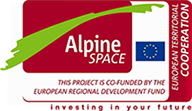p r o d u c t s
(3) Permafrost and related natural hazards
Which hazards are related to permafrost?
A state of the art report about permafrost-related hazards and permafrost degradation was elaborated. Its four chapters deal with rock glaciers, debris flows, rockfalls, and local ground movements and their effects on infrastructure. Each chapter summarizes present knowledge about these processes and their relationship to the climate change, and is illustrated by several recent case studies in the Alps. These case studies show the variety of effects on infrastructures in high mountain areas.
What can occur if climate changes modify permafrost regimes?
Rock glaciers are creeping accumulations of debris, usually moving at a rate of cm or dm per year. Observed rock glacier dynamics show climatically-induced variations in velocity. In most cases only moderate velocity changes occur, related to annual changes of the mean annual ground surface temperature: an increase in ground temperature induces an acceleration of movements, and inversely. In some cases, a very strong and non-reversible acceleration, up to decameters per year, was observed. This can generate rockfall activity at the rock glacier front, and progression or even rupture and collapse of its front.
A detailled description can be found here.
All surface movements can cause damage to infrastructures built on the moving terrain. Small movements can be accommodated by adapted design, but the potential accelerations induced by climate warming could challenge even these. In any case, building on permafrost induces additional construction and maintenance costs, and reduces the lifetime of infrastructures.
A detailled description can be found here.
Rockfalls generate risks for mountaineering activities in the Alps and infrastructure like cable cars, mountain railways and roads, or ski resorts. Rock avalanches can threaten valley inhabitants at long distance from the source area. Climatically-driven degradation of rockwall permafrost is probably one of the main triggers of recent, present and future rockfalls, as suggested
by the massive ice that was observed in several starting zones, and the increase > 1°C of the mean annual air temperature in the Alps during the 20th Century, accelerated since the 1980s.
A detailled description can be found here.
Where rock glacier fronts overhang steep slopes, secondary processes can mobilize the released debris downslope. This and rockfall activity in permafrost areas can increase, for instance, the debris supply and thus the volume of debris flows. Permafrost can influence debris flow activity in different ways, mainly by increasing the debris supply to the torrential system, but also by influencing the water runoff characteristics. But, the influence of permafrost on debris flow activity depends mostly on the specific characteristics of the torrent catchment. The melting of ice in permafrost soils or scree slopes in the course of active layer thickening can lead to the loss of internal ice as stabilising binding material. This can lead to the increased availability of erodible material, to the subsidence of soils in flat areas and to slope movements in inclined slopes. In steep slopes, permafrost influences hydraulic conductivity and overall slope stability. In summertime, the active layer is often saturated because of the characteristics of the permafrost table as acquiclude. Thus, infiltration capacity is low and superficial runoff is high. The permafrost table can act as a slide horizon for landslides in the active layer. Consequences of this can be the sliding of debris cover, the settling of debris and related slope movements or landslides. The melting of ground ice contributes to the formation of thermokarst phenomena and thermokarst lakes with subsequent lake outburst floods.
A detailled description can be found here.
Which actions are needed to face increasing risks in affected locations?
The described processes related to permafrost and permafrost degradation do not influence hazard situations over wide areas. However, in single cases they could have a remarkable influence on hazard and risk situations. The first step in each planning activity is to refer to the permafrost distribution map. If the map shows a possible presence of permafrost at the study site, the use of permafrost detection methods as described in the PermaNET handbook is recommended. If permafrost is to be considered, special monitoring methods support the analysis of the processes. In order to evaluate operational approaches for detection and monitoring of slope movements and ground temperature in permafrost areas, six method sheets were established about dGPS, GPR, DInSAR, ERT, TLS, and terrestrial photogrammetry. Basic principles of each method are summarized, before listing their possible applications, and the main results, opportunities and limitations; each sheet is completed with references and illustrated with some figures. Comparisons between some pairs of these methods were realized, and a SWOT analysis completed this assessment.
Recommendations were made to reduce hazards in a permafrost environment. For example: (i) infrastructures on an active rock glacier and its front zone should be avoided; (ii) a security zone should be observed below an overhanging rock glacier; (iii) trails crossing rock glaciers or passing down below its front should be regularly checked.
A detailled description of recommendations can be found in the PermaNET Synthesis report.


